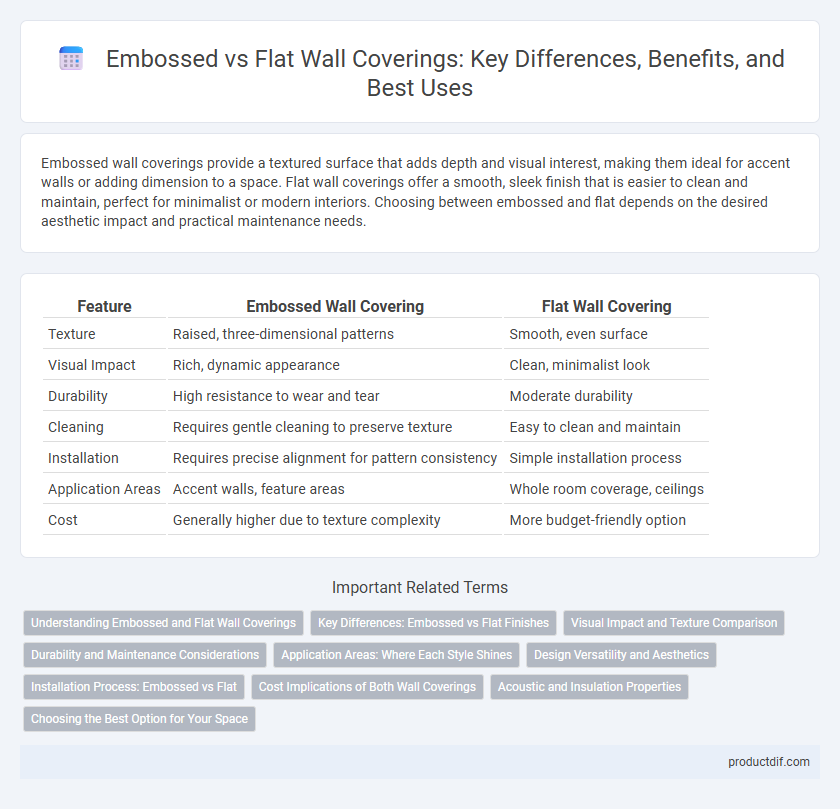Embossed wall coverings provide a textured surface that adds depth and visual interest, making them ideal for accent walls or adding dimension to a space. Flat wall coverings offer a smooth, sleek finish that is easier to clean and maintain, perfect for minimalist or modern interiors. Choosing between embossed and flat depends on the desired aesthetic impact and practical maintenance needs.
Table of Comparison
| Feature | Embossed Wall Covering | Flat Wall Covering |
|---|---|---|
| Texture | Raised, three-dimensional patterns | Smooth, even surface |
| Visual Impact | Rich, dynamic appearance | Clean, minimalist look |
| Durability | High resistance to wear and tear | Moderate durability |
| Cleaning | Requires gentle cleaning to preserve texture | Easy to clean and maintain |
| Installation | Requires precise alignment for pattern consistency | Simple installation process |
| Application Areas | Accent walls, feature areas | Whole room coverage, ceilings |
| Cost | Generally higher due to texture complexity | More budget-friendly option |
Understanding Embossed and Flat Wall Coverings
Embossed wall coverings feature raised patterns or textures created by pressing designs onto materials, adding depth and tactile interest to surfaces. Flat wall coverings have a smooth, uniform appearance without texture, providing a sleek and modern finish ideal for minimalist interiors. Choosing between embossed and flat wall coverings depends on desired aesthetic impact, durability, and the ability to hide surface imperfections.
Key Differences: Embossed vs Flat Finishes
Embossed wall coverings feature raised patterns and textures that create a three-dimensional effect, enhancing depth and tactile interest, while flat finishes provide a smooth, uniform surface ideal for a sleek, modern look. Embossed finishes are more durable and can hide wall imperfections better than flat finishes, which tend to reveal flaws more easily. Maintenance differs as embossed surfaces may require gentle cleaning to preserve texture, whereas flat finishes allow for straightforward wiping and repainting.
Visual Impact and Texture Comparison
Embossed wall coverings offer a three-dimensional texture that adds depth and visual interest, making walls stand out with intricate patterns and tactile appeal. Flat wall coverings provide a smooth, uniform surface that enhances color richness and creates a sleek, minimalist aesthetic. The choice between embossed and flat designs significantly affects the room's ambiance, with embossed textures delivering dynamic shadows and flat finishes emphasizing bold color statements.
Durability and Maintenance Considerations
Embossed wall coverings offer enhanced durability due to their textured surface, which resists wear and masks minor damage better than flat designs. Flat wall coverings provide a smooth finish that is easier to clean but may show scuffs and stains more prominently. Maintenance of embossed materials often involves gentle dusting to preserve the raised patterns, while flat surfaces can typically withstand more frequent wiping with mild cleaners.
Application Areas: Where Each Style Shines
Embossed wall coverings excel in application areas requiring texture and depth such as feature walls in living rooms, restaurants, and luxury hotels, enhancing tactile appeal and visual interest. Flat wall coverings are ideal for high-traffic areas like offices, retail stores, and minimalist interiors where smooth surfaces facilitate easy cleaning and maintain a sleek, modern look. Choosing between embossed and flat styles depends on the desired aesthetic impact and functional needs of the space.
Design Versatility and Aesthetics
Embossed wall coverings offer enhanced design versatility with textured patterns that create depth and visual interest, making spaces feel more dynamic and luxurious. Flat wall coverings provide a sleek, smooth surface ideal for minimalist or modern aesthetics, allowing for easier application of bold colors and intricate prints. Choosing between embossed and flat designs depends on the desired ambiance and architectural style, balancing tactile richness with clean simplicity.
Installation Process: Embossed vs Flat
Embossed wall coverings require more precise alignment during installation to ensure the raised patterns match seamlessly, often demanding skilled labor and additional time compared to flat wall coverings. Flat wall coverings typically install more quickly and easily due to their smooth, uniform surface, allowing for straightforward adhesive application and fewer alignment challenges. Proper surface preparation is critical for both types, but embossed designs may necessitate extra care to avoid damaging the textured elements during handling and installation.
Cost Implications of Both Wall Coverings
Embossed wall coverings typically incur higher costs due to the complexity of manufacturing processes and specialized materials required to create textured patterns, leading to increased production time and labor expenses. Flat wall coverings are generally more affordable, benefiting from simpler designs and mass production methods that reduce material waste and installation time. Choosing between embossed and flat wall coverings depends on budget considerations, with embossed options demanding a premium for aesthetic depth while flat coverings offer cost-efficient coverage and ease of maintenance.
Acoustic and Insulation Properties
Embossed wall coverings offer enhanced acoustic properties by creating textured surfaces that diffuse sound waves, reducing noise levels more effectively than flat wall coverings. The raised patterns in embossed designs also improve thermal insulation by trapping air in the embossed cavities, contributing to better temperature regulation. Flat wall coverings, while providing a smooth aesthetic, lack these sound-dampening and insulating benefits, making embossed options preferable for spaces requiring improved acoustic control and energy efficiency.
Choosing the Best Option for Your Space
Embossed wall coverings offer textured surfaces that add dimension and visual interest, making them ideal for accent walls and spaces seeking depth. Flat wall coverings provide a smooth, uniform appearance that enhances light reflection and suits minimalist or modern interiors. Selecting between embossed and flat options depends on your design goals, room size, and desired ambiance to achieve the best aesthetic and functional outcome.
Embossed vs Flat Infographic

 productdif.com
productdif.com